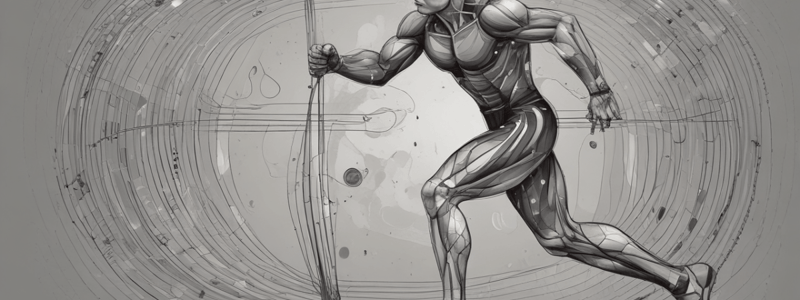Podcast
Questions and Answers
Match the following attributes with the corresponding type of muscle fibre:
Match the following attributes with the corresponding type of muscle fibre:
Type I = Fibre recruitment for tasks requiring low force and endurance Type IIa = Fibre recruitment for tasks requiring moderate force and speed Type IIx = Fibre recruitment for tasks requiring high force and speed Type II = Fibre recruitment for tasks requiring high force and low endurance
Match the following energy systems with their corresponding role in ultra-short term performances:
Match the following energy systems with their corresponding role in ultra-short term performances:
ATP-PC = Primary energy system for generating power Glycolysis = Secondary energy system for generating energy Phosphocreatine = Energy storage system for high-intensity activities Oxidative phosphorylation = Energy system for low-intensity activities
Match the following factors with their influence on ultra-short term performances:
Match the following factors with their influence on ultra-short term performances:
Motivation = Impacts fibre recruitment and power development Skill and technique = Affects fatigue and performance Arousal = Impacts neuromuscular drive and power output Creatine supplements = Improves performance by increasing phosphocreatine levels
Match the following characteristics with their corresponding type of performance:
Match the following characteristics with their corresponding type of performance:
Match the following limitations with their impact on performance:
Match the following limitations with their impact on performance:
Match the following factors with their impact on fatigue in ultra-short term performances:
Match the following factors with their impact on fatigue in ultra-short term performances:
Match the following energy systems with their corresponding duration of activity:
Match the following energy systems with their corresponding duration of activity:
Match the following aspects with their importance in ultra-short term performances:
Match the following aspects with their importance in ultra-short term performances:
Match the following terms with their definitions:
Match the following terms with their definitions:
Match the following terms with their definitions:
Match the following terms with their definitions:
Match the following methods with their uses:
Match the following methods with their uses:
Match the following concepts with their descriptions:
Match the following concepts with their descriptions:
Match the following terms with their descriptions:
Match the following terms with their descriptions:
Match the following methods with their uses:
Match the following methods with their uses:
Match the following concepts with their descriptions:
Match the following concepts with their descriptions:
Match the following terms with their descriptions:
Match the following terms with their descriptions:
Match the following statements with their corresponding intensity levels:
Match the following statements with their corresponding intensity levels:
Match the following genetic types with their associated characteristics:
Match the following genetic types with their associated characteristics:
Match the following factors with their impact on exercise performance:
Match the following factors with their impact on exercise performance:
Match the following with their corresponding characteristics:
Match the following with their corresponding characteristics:
Match the following with their corresponding roles in exercise performance:
Match the following with their corresponding roles in exercise performance:
Match the following with their corresponding effects on exercise performance:
Match the following with their corresponding effects on exercise performance:
Match the following with their corresponding relationships with exercise performance:
Match the following with their corresponding relationships with exercise performance:
Match the following with their corresponding characteristics:
Match the following with their corresponding characteristics:
Flashcards
Biological Limitations
Biological Limitations
Factors that restrict an individual's performance, but can be improved with training and/or supplementation.
Muscle Fiber Recruitment
Muscle Fiber Recruitment
The process of activating different muscle fibers (type I, IIa, IIx) as exercise intensity increases.
Type I Muscle Fibers
Type I Muscle Fibers
Slow-twitch fibers used for endurance activities.
Type IIa Muscle Fibers
Type IIa Muscle Fibers
Signup and view all the flashcards
Type IIx Muscle Fibers
Type IIx Muscle Fibers
Signup and view all the flashcards
Anaerobic Pathways
Anaerobic Pathways
Signup and view all the flashcards
Ultra Short-Term Performance
Ultra Short-Term Performance
Signup and view all the flashcards
ATP-PC System
ATP-PC System
Signup and view all the flashcards
Glycolysis
Glycolysis
Signup and view all the flashcards
Creatine Supplements
Creatine Supplements
Signup and view all the flashcards
Muscle Strength
Muscle Strength
Signup and view all the flashcards
Max Dynamic Strength
Max Dynamic Strength
Signup and view all the flashcards
1RM
1RM
Signup and view all the flashcards
3RM
3RM
Signup and view all the flashcards
Power
Power
Signup and view all the flashcards
Strength Endurance
Strength Endurance
Signup and view all the flashcards
Genetic Limitations
Genetic Limitations
Signup and view all the flashcards
VO2max
VO2max
Signup and view all the flashcards
High Responders
High Responders
Signup and view all the flashcards
Low Responders
Low Responders
Signup and view all the flashcards
Anaerobic Capacity
Anaerobic Capacity
Signup and view all the flashcards
Pulmonary Function
Pulmonary Function
Signup and view all the flashcards
Exercise Economy
Exercise Economy
Signup and view all the flashcards
Study Notes
Understanding Biological Limitations
- Biological limitations can be overcome or mitigated with training and supplementation, or used to identify talented individuals.
- Understanding these limitations informs strategic decisions about training and competition.
Muscle Fibre Recruitment
- As exercise intensity increases, muscle fibre recruitment progresses from type I → type IIa → type IIx.
- ATP supply needed for tension development becomes more dependent on anaerobic pathways, leading to specific fatigue.
Factors Limiting All-Out Anaerobic Performances
- Ultra short-term performances (less than 10 seconds) rely on type 2 muscle fibres, motivation, skill, and arousal.
- Primary energy systems are ATP-PC and glycolysis, with a focus on phosphocreatine.
- Creatine supplements may improve performance.
- Fibre type distribution and recruitment, as well as motivation and arousal, are crucial for performance.
- Peak power, mean max power, and repeat sprint capacity are measures of anaerobic performance.
Muscle Strength and Power
- Muscle strength is defined as max force production capabilities of a muscle.
- Max dynamic strength can be assessed using 1RM or 3RM.
- Power is the combination of peak force and contraction velocity.
- To test for power, a force plate is required.
- Strength endurance involves consistency and repeated effort, and can be tested using a metronome.
Physiological Limitations to Performance
- Understanding physiological limitations informs training and competition strategies.
- Pulmonary function may not be a limiting factor in exercise performance, except in high-intensity exercise with incomplete gas exchange.
Genetic Limitations
- Genetics play a role in determining training response and athletic ability.
- 97 different genes contribute to training improvements and responses in VO2max.
- High responders can achieve 50% improvement in VO2max, while low responders may only see a 2-3% improvement.
- Anaerobic capacity is more genetically determined than aerobic capacity.
- Genetics influence high VO2max, exercise economy, lactate threshold, and critical power.
Studying That Suits You
Use AI to generate personalized quizzes and flashcards to suit your learning preferences.





